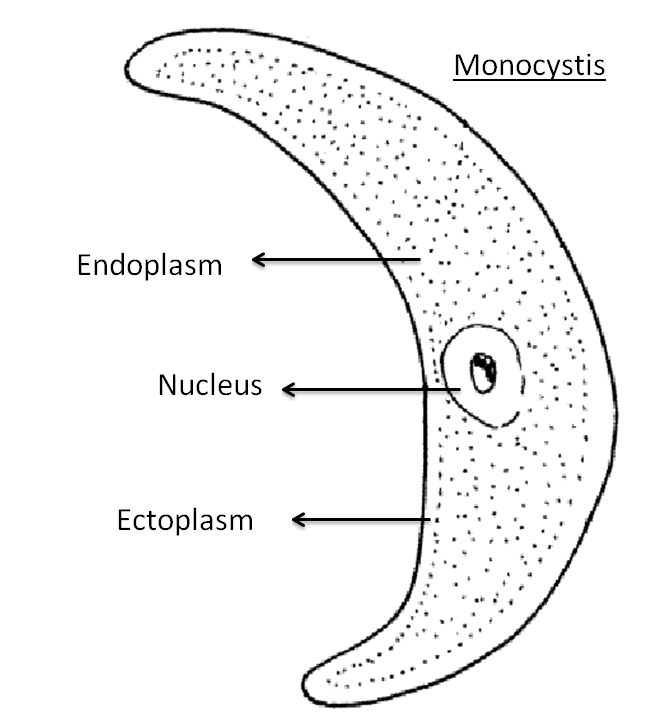
Monocystis belongs to the order of
(a)Gregarinida
(b)Coccidia
(c)Microsporidia
(d)Sarcosporidia
Answer
484.8k+ views
Hint: Monocystis is an internal parasite in the reproductive system of earthworms. Monocystis do not have protoplasm divided into segments by septa.
Complete answer:
Monocystis belong to Conoidasida- class, Gregarinasina- subclass, and Eugregarinorida order whereas sarcoporidia is an order of coccidian. Eugregarinorida order includes protozoa which are mainly parasitic to many invertebrates. They have large trophozoites that possess septate species or aseptate species. The presence of stiff cells on the surface for gliding movement forms epicyctic folds on their surface.

Additional Information:
-During the young stage, monocystis lives as an intracellular parasite in the bundle of developing sperms of earthworm where it lives and feeds the protoplasm of developing sperm makes the sperm dead surround by tails which is easily mistaken as ciliated organism.
-During the mature stage, monocystis is known as trophozoite and lives as an extracellular parasite in the seminal vesicles of the earthworm.
-The presence of monocystis in the earthworm is the common infection in mostly all mature earthworms.
-Monocystis doesn't have any locomotory organ thus shows wriggling and gliding movements.
-Monocystis stores its food material in the form of glycogen granules in the endoplasma.
-The outer thick and thick structure surrounding the body of trophozoite is called pellicle which is used as the mode of respiration by the process diffusion.
-Monocystis shows sexual reproduction.
So, the correct answer is, ‘Gregarinida.’
Note:
-Monocystis completes its life cycle in one host thus known as a monogenetic parasite.
-Monocystis found in the coelom and seminal vesicle of the earthworm.
-Monocystis contains four chromosomes in the nucleus.
-They show cylindroids, solitary and coelomic habitat in the earthworm.
Complete answer:
Monocystis belong to Conoidasida- class, Gregarinasina- subclass, and Eugregarinorida order whereas sarcoporidia is an order of coccidian. Eugregarinorida order includes protozoa which are mainly parasitic to many invertebrates. They have large trophozoites that possess septate species or aseptate species. The presence of stiff cells on the surface for gliding movement forms epicyctic folds on their surface.

Additional Information:
-During the young stage, monocystis lives as an intracellular parasite in the bundle of developing sperms of earthworm where it lives and feeds the protoplasm of developing sperm makes the sperm dead surround by tails which is easily mistaken as ciliated organism.
-During the mature stage, monocystis is known as trophozoite and lives as an extracellular parasite in the seminal vesicles of the earthworm.
-The presence of monocystis in the earthworm is the common infection in mostly all mature earthworms.
-Monocystis doesn't have any locomotory organ thus shows wriggling and gliding movements.
-Monocystis stores its food material in the form of glycogen granules in the endoplasma.
-The outer thick and thick structure surrounding the body of trophozoite is called pellicle which is used as the mode of respiration by the process diffusion.
-Monocystis shows sexual reproduction.
So, the correct answer is, ‘Gregarinida.’
Note:
-Monocystis completes its life cycle in one host thus known as a monogenetic parasite.
-Monocystis found in the coelom and seminal vesicle of the earthworm.
-Monocystis contains four chromosomes in the nucleus.
-They show cylindroids, solitary and coelomic habitat in the earthworm.
Recently Updated Pages
Master Class 11 Accountancy: Engaging Questions & Answers for Success

Glucose when reduced with HI and red Phosphorus gives class 11 chemistry CBSE

The highest possible oxidation states of Uranium and class 11 chemistry CBSE

Find the value of x if the mode of the following data class 11 maths CBSE

Which of the following can be used in the Friedel Crafts class 11 chemistry CBSE

A sphere of mass 40 kg is attracted by a second sphere class 11 physics CBSE

Trending doubts
10 examples of friction in our daily life

One Metric ton is equal to kg A 10000 B 1000 C 100 class 11 physics CBSE

Difference Between Prokaryotic Cells and Eukaryotic Cells

State and prove Bernoullis theorem class 11 physics CBSE

What organs are located on the left side of your body class 11 biology CBSE

How many valence electrons does nitrogen have class 11 chemistry CBSE




